There is more than one way to roast garlic! Most people roast a head of garlic by wrapping it up in aluminum foil and putting it in a hot oven. In recent years I have worked to reduce the amount of aluminum in my cooking process. Through trial and error I have found many different ways to roast garlic without it being wrapped in foil, both in the oven and on the stovetop, with a whole head or with pre-peeled garlic cloves. Read on to learn how!

One of my very first blogs back in 2010 was a tutorial on roasted garlic. Since that time I’ve learned quite a few different methods to achieve perfectly roasted, tender and golden brown caramelized garlic cloves. At the same time, I have worked to reduce my aluminum foil usage due to growing concerns that chronic aluminum exposure may increase the risk of Alzheimer’s disease. I figured it’s time to refresh this garlic roasting tutorial with the many new methods I now use in my own kitchen, all of which reduce direct exposure to aluminum.
For those of you who are garlic lovers, the soft smoky cloves can be spread straight onto bread as a condiment (it’s especially yummy paired with goat cheese on toasted french bread or with a simple sprinkle of salt and pepper). It can also be substituted for raw garlic in many recipes to give a milder, more delicate flavor– like in hummus, baba ghanoush, or falafel.
How do you store roasted garlic?
Roasted garlic doesn’t keep very well in the refrigerator, so it’s best to use it within a few hours after making it. Fortunately, you can easily freeze cloves for future use. I like to keep a batch roasted garlic cloves in my freezer so that I have it on hand for impulsive hummus and baba ghanoush cravings! They can be frozen by removing the cloves from the head (if you’ve roasted whole heads of garlic), and removing individual cloves of garlic from the olive oil with a slotted spoon. Spread the roasted cloves on a small baking sheet and place in the freezer until firm, then transfer the frozen cloves to a sealed container or freezer bag and freeze until ready to serve.
Is oven roasted garlic healthy?
Garlic is a major ingredient in Middle Eastern and Mediterranean cooking, and I adore the flavor, but raw garlic hard on my stomach. Roasting garlic in the oven before adding it to certain dishes makes it much easier to digest. I also love the flavor that roasting brings out of garlic– it adds depth, makes it tender, and gives it a mild smoky sweetness that is just lovely. According to Consumer Reports, roasted garlic may also help lower blood pressure and cholesterol, and offer an anti-inflammatory effect, a reduced risk of cancer, and a stronger immune system.
Here are my five tried-and-true methods for roasting garlic. Each one has its own advantages, so use whatever works best for you and your kitchen. All of the methods are very simple, and the results are super yummy. I hope it’s helpful to you!
More Garlic Recipes
Olive Oil Mashed Potatoes with Garlic and Rosemary
Recommended Products
Hungry for more? Find me on Facebook, Twitter, Pinterest, YouTube and Instagram for all the latest updates!
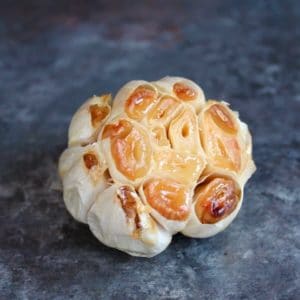
How to Roast Garlic - Five Easy Methods
Ingredients
- 1 head of garlic , or more as needed
- Olive oil
Instructions
Preparing the Garlic Head for Roasting
- The following methods will detail various ways you can roast a head of garlic in the oven. The key to oven roasting is making sure that the garlic is both roasted and steamed at the same time, so the cloves don't dry out. For all of these methods, you will need to prepare the whole head of garlic prior to roasting. If you only have garlic cloves and not the whole head, skip to the stovetop roasting method at the end of this tutorial.

- To prepare a whole head of garlic for roasting, peel the outer skin from the garlic head, leaving the cloves intact in their casings. Peel gently and carefully to ensure no garlic cloves separate from the head.

- Slice the top part of the garlic head off, leaving the cloves exposed. All of the cloves need to have a small portion exposed to roast properly, so check around the edges and slice off any additional clove tips as needed.From here, you have a few different options for roasting. All of these methods seek to eliminate direct contact between aluminum foil and the garlic.

Roast Garlic in a Muffin Pan
- The first method, which I use most often, involves using two muffin pans of the same size. This allows you to roast a lot of garlic at once. You can roast just one head, or up to 12 - one in each cup. Place your heads of garlic into the pan, cut side up, one head in each muffin cup.

- Preheat oven to 400 degrees F. Drizzle each head of garlic with about 2 tsp of olive oil each, making sure all of the exposed cloves and surfaces are coated with a light layer of oil. Use your fingers to massage the oil gently around the head of garlic to ensure even coverage.

- Place the other muffin pan inverted directly on top of the pan with the garlic, so that each muffin cup is covered by another muffin cup.

- Roast in the oven for about 40-45 minutes, or until the heads of garlic are tender, aromatic and caramelized.

Roast Garlic in a Loaf Pan
- The next method involves using a small loaf pan or baking dish. Preheat oven to 400 degrees F and prepare the garlic heads as described above. Place your prepared heads of garlic into the loaf pan and drizzle with 2 tsp of olive oil each, coating the heads evenly.

- Because loaf pans don't have lids, you will need to cover the pan. Aluminum foil is the best way to do over the pan securely. The foil won't actually touch the garlic heads, but to be extra safe I first use a piece of parchment to cover the pan...

- Then I secure the parchment in place with a layer of foil. Roast in the oven for about 40-45 minutes, or until the heads of garlic are tender, aromatic and caramelized. Be careful when opening the foil and parchment, hot steam will have gathered during cooking.

Roast Garlic in a Roasting Dish - Ceramic or Cast Iron
- If you roast a lot of garlic you can purchase a garlic roasting dish with lid. Here is a ceramic option. If you want the ability to also roast on the grill, this cast iron one is pretty neat too. Check your dish for instructions for the recommended temperature and time required. Preheat oven to that temperature.Place prepared garlic heads in the dish. Drizzle each garlic head with 2 tsp of olive oil each, coating the heads evenly. Cover the roasting dish and roast for the recommended time at the recommended temperature. For my dish, it is 300 degrees for 1 hour. At the end of the hour, I like to uncover the dish, raise the temperature to 400 and let it roast for 10-15 minutes longer to achieve some caramelization. You can experiment with your dish to see what works best for you.

Roasting Garlic in a Parchment and Foil Packet
- This method involves aluminum foil, but the head of garlic is separated from the foil by a layer of parchment. Preheat oven to 400 degrees F and prepare the garlic heads as described above. For each head of garlic, cut a square of parchment paper and another square of foil, both large enough to wrap around the head of garlic completely. Place the foil on a flat surface and layer the parchment on top. Place the garlic head in the center of the parchment square and drizzle with olive oil.

- Wrap up the garlic in the parchment, crumpling the paper at the top to create a pouch. Secure the pouch with the layer of foil, wrapping it around the parchment to create a sealed pouch.

- Roast in the hot oven for 40-45 minutes until the cloves are soft and tender. In the packet the garlic will steam more than roast, and it won't really caramelize. However, you can take the garlic out of the packet at the end of cooking (careful, hot steam will come out!), place it on a baking tray, and let it roast in the hot oven for 10-15 minutes longer to achieve some caramelization if you wish.

Removing the Roasted Garlic Cloves
- After you have roasted your head of garlic using any of the methods above, remove the roasted cloves by pulling the head apart, clove by clove, then gently squeezing each clove casing.
Roasting Cloves of Garlic on the Stovetop
- Grocery stores now sell pre-peeled garlic cloves, which are very convenient. But what if you want to roast them? Try this nifty method will allow you to roast many whole cloves at once.

- Take a small saucepan or skillet and pour in 6 tbsp of olive oil. Add your whole cloves to the pan. You can roast quite a few at the same time, I have done up to 25-30 at a time with good results. Don't overcrowd the pan.
- Heat the olive oil on medium for 2-3 minutes, watching carefully the whole time, until it just begins to sizzle around the cloves. Don't let them sizzle too long or you'll start to fry the cloves.
- Reduce heat immediately to between low and medium low. Stir well to coat the garlic cloves in hot oil. Let the garlic cook slowly for 20-30 minutes, stirring and flipping the cloves every few minutes, until the cloves are soft, tender and golden.
- Remove cloves from the oil with a slotted spoon. Allow the oil to cool.
- This method will also leave you with a nice garlic-infused olive oil to use for cooking or in salad dressings. Refrigerate the oil until ready to use.
How to Keep Roasted Garlic
- Roasted garlic should be used within a few hours of making. It doesn't keep very well in the refrigerator, but you can easily freeze cloves for future use. I keep a batch of frozen roasted garlic that I thaw for quick batches of hummus and baba ghanoush.
- Remove garlic cloves from the head, if you've roasted a whole head. For roasted cloves, separate them from the olive oil with a slotted spoon. Spread the roasted cloves on a small baking sheet and freeze until firm, then put the frozen cloves into a sealed container or freezer bag. Freeze until ready to serve.
- Alternatively, you can mash the roasted cloves and measure out teaspoon-sized portions, which can be stored in an ice cube tray. The tray should be reserved for this purpose, as it will absorb the smell of the garlic.

Nutrition

tried this recipe?
Let us know in the comments!
We are a participant in the Amazon Services LLC Associates Program, an affiliate advertising program designed to provide a means for us to earn fees by linking to Amazon.com and affiliated sites. As an Amazon Associate I earn from qualifying purchases.

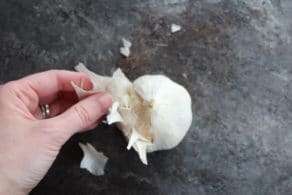
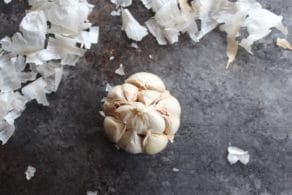
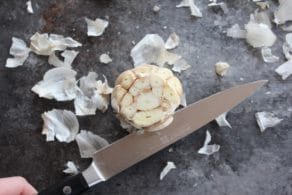
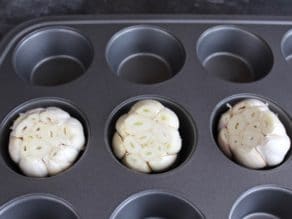
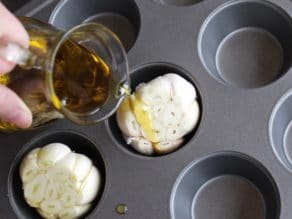
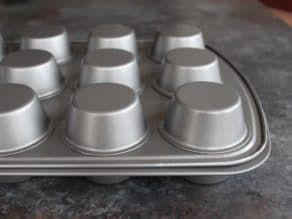
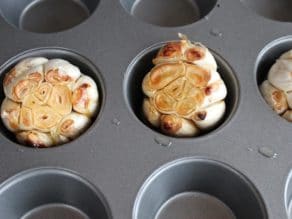
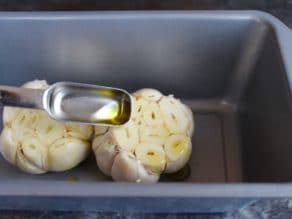
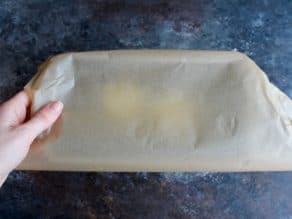
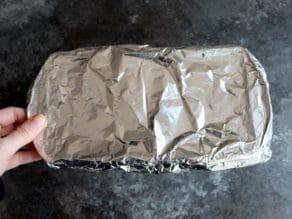
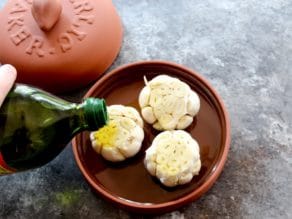
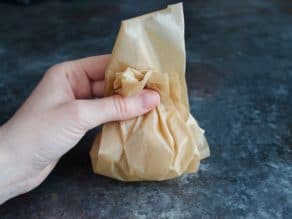






Thank you for the foil-free tips, Tori!
What about roasting just a couple of cloves at a time for one person?
To do that I would recommend the stovetop method (using a skillet and oil to roast) – instructions in the post.
I was forwarded your blog post with for a falafel recipe. Glad I found this primer on garlic roasting for smaller amounts 🙂
I DONT BAKE ALOT. I use a broiler.
How do prepare the garlic in the broiler without burning it.
Thank You.
In this case, I would use the stovetop method. A broiler’s heat is too intense and fast for even roasting of garlic cloves.
Understand that nutritional info is for an entire head of garlic. But sizes vary. Can you consider reevaluating based on a more specific and finite measure (tsp, tbsp, etc.)?
Hi Lorrie, unfortunately I am not a nutritionist. My site auto-calculates nutrition based on the recipe ingredients. For a more precise measurement, I suggest using one of the many nutrition calculators online to calculate for your specific needs.
Glass or ceramic ramekins work very well too for this purpose
Hi Tori, thanks for your tips on roasting garlic. I have been doing it for a while now using the little parcels method. Have been thinking of trying other methods just so as to not use so much aluminium from a cost point of view more than anything else. Very hard to resist eating them all at once as they are squeezed out. They are so sweet. I use a tiny little coffee spoon to scoop them out of the husks. Just wondering if using the muffin tin method, does the smell of the garlic stay in the pans or should I have specific pans for garlic only?
Thanks for giving me options.
Regards
Ann
Most appreciative of this thread. Inasmuch as I am altogether v.much a “regular guy…….”, not some dreadful new age, immediately triggered high wire act that looks upon everything with suspicion when it comes to food, e.g., I LOVE a great hot dog, as well, cheeseburgers, butter and salt are the bomb, thank you………, for well into three decades I, too have avoided aluminum in all manner in cooking whenever possible. The stuff ain’t good, folks…….. Oh, and just so you know……., I ain’t into Feng Shui. Trust me, I AM a regular kinda guy.
Therefore, this process of baking garlic sans aluminum should be read – adopted by many more. One thing……….. I tone down the oven to 350 fahrenheit as when higher the sugars in garlic tend to burn. And when sauteeing with garlic, the same applies……….. Low heat so as not to burn. It’s amazing stuff, a little goes a long way.
Thankos Muchos. You take care Tori Avey. You take care………………….
Thanks John! I thought this might be helpful to quite a few folks out there. 🙂
If you shockingly have leftover roast garlic, what is the best way to reheat it?
Are they cloves or a whole head? For cloves I would slowly reheat in olive oil on the stovetop… keep oil at a low temp so it doesn’t fry the garlic. A whole head, I’ve never had to reheat… if I were trying it I might put it in a covered baking dish with a little water in the bottom, in a 350 degree oven until warmed through.
Hi Tory….I am a 76 year old lady who has been cooking for my children, grandchildren and friends for fifty years. I am considered a good cook, not only with my family but also keep up with the new generation of eating healthy, organic foods and always looking for “that perfect recipe.” My Jewish Grandma and Mother made the best pot roast ever but never had a recipe. I made your Holiday brisket and it was the biggest hit. In fact it tasted and had the aroma of my Grandma’s kitchen. I love your recipes and they are now my go-to when I want a perfect dish to serve. Also, I agree with your method of avoiding aluminum foil while cooking. I have been using the parchment covered with foil method for the past 10 years. For those writers who add negative comments, I suggest they leave them out and rave about your recipes. Thank you for your wonderful, easy to follow recipes.
Thanks Marilyn!
Wow, completely fantastic! Thanks Tori!!!